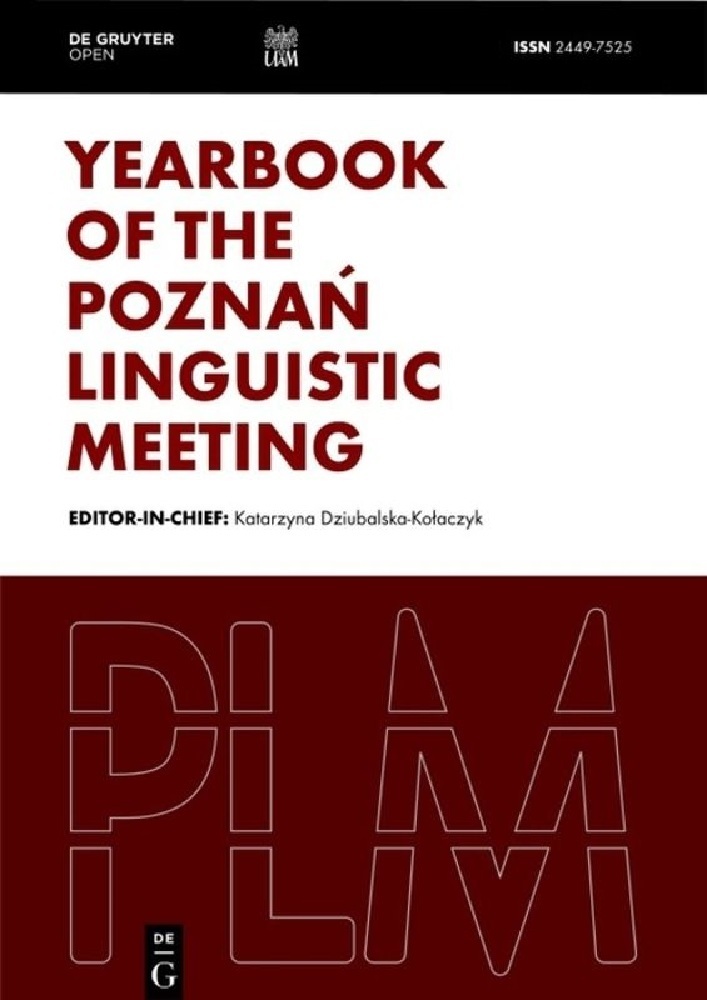Abstract
Semantic prosody is typically referred to as an evaluative function of certain words or multiword items appearing within collocates of positive or negative meaning. The present study deals with the semantic prosody (context properties) of extended lexical units (ELUs) according to the psycholinguistic variables ‘valence’ (emotional positivity), ‘arousal’ (excitement, mood-enhancement), and ‘concreteness’. The object of investigation are the verbal phrases feel blue (unambiguous idiomatic ELU, without a literal counterpart) and see red (ambiguous ELU, idiomatic or literal). The study builds on Snefjella & Kuperman (2016) who propose context norms for English words on the basis of a USENET mega-corpus. For the detection of ELU representations, a questionnaire-based survey was conducted with speakers of American English. For the detection of the context values of ELUs, a corpus research was carried on by using the Corpus of Contemporary American English (COCA) and the News on the Web corpus (NOW). The results suggest that ELU contexts largely conform to the averaged context norms of ELU constituents. ELU representations are strongly dissociated from contexts.
References
Berlin, Brent & Paul Kay. 1969. Basic color terms. Their universality and evolution. Berkeley, CA: University of Los Angeles Press.
Brysbaert, Marc, Amy Beth Warriner & Victor Kuperman. 2014. Concreteness ratings for 40 thousand generally known English word lemmas. Behavior Research Methods 46. 904–911.
Citron, Francesca M.M., Cristina Cacciari, Michael Kucharski, Luna Beck, Markus Conrad & Arthur M. Jacobs. 2016. When emotions are expressed figuratively: Psycholinguistic and Affective Norms of 619 Idioms for German (PANIG). Behavior Research Methods 48. 91–111.
Friedman, Milton. 1937. The use of ranks to avoid the assumption of normality implicit in the analysis of variance. Journal of the American Statistical Association 32. 675–701.
Hauser, David J. & Norbert Schwarz. 2016. Semantic prosody and judgment. Journal of Experimental Psychology: General 145(7). 882–896.
Hoey, Michael. 2005. Lexical priming: A new theory of words and language. Lon-don/New York: Routledge.
Hunston, Susan. 2007. Semantic prosody revisited. International Journal of Corpus Linguistics 12(2). 249–268.
Kay, Paul & Chad K. McDaniel. 1978. The linguistic significance of the meanings of basic color terms. Language 54(3). 610–646.
Köper, Maximilian & Sabine Schulte im Walde. 2016. Automatically Generated Norms of Abstractness, Arousal, Imageability and Valence for 350,000 German Lemmas. In: Proceedings of the 10th Conference on Language Resources and Evaluation (LREC). Portorož, Slovenia, May 2016.
Kuperman, Victor. 2013. Accentuate the positive: Diagnostics of semantic access in English compounds. Frontiers in Language Sciences 4(203). 1–10.
Lakoff, George & Mark Johnson. 1980. Metaphors we live by. Chicago: University of Chicago Press.
Louw, Bill. 1993. Irony in the text or insincerity in the writer? The diagnostic potential of semantic prosodies. In Mona Baker, Gill Francis & Elena Tognini-Bonelli (eds.), Text and Technology: In Honour of John Sinclair, 157–176. Amsterdam: Benjamins.
Lynott, Dermot, Louise Connell, Marc Brysbaert, James Brand & James Carney. 2020. The Lancaster Sensorimotor Norms: Multidimensional measures of perceptual and action strength for 40,000 English words. Behavior Research Methods 52. 1271–1291.
Morley, John & Alan Partington. 2009. A few Frequently Asked Questions about semantic – or evaluative – prosody. International Journal of Corpus Linguistics 14(2). 139–158.
Partington, Alan. 2004. “Utterly content in each other’s company”: semantic prosody and semantic preference. International Journal of Corpus Linguistics 9(1). 131–156.
Regier, Terry, Paul Kay & Richard S. Cook. 2005. Focal colors are universal after all. In Proceedings of the National Academy of Sciences 102(23). 8386–8391.
Rundell, Michael. 2018. Searching for extended units of meaning – and what to do when you find them. Lexicography 5(1). 5–21.
Shaoul, Cyrus & Chris Westbury. 2013. A reduced redundancy usenet corpus (2005–2011). Edmonton, AB: University of Alberta. www.psych.ualberta.ca
Sinclair, John. 2004. Trust the text: Language, Corpus, and discourse. London/New York: Routledge.
Snefjella, Bryor & Victor Kuperman. 2016. It’s all in the delivery: Effects of context valence, arousal, and concreteness on visual word processing. Cognition 156. 135–146.
Stewart, Dominic. 2010. Semantic Prosody: A Critical Evaluation. New York: Routledge.
Stubbs, Michael. 2009. The search for units of meaning: Sinclair on empirical semantics (memorial article). Applied Linguistics 30(1). 115–137.
Tang, Xuri & Gaixiang Liu. 2018. Solving contradictions in semantic prosody analysis with prosody concord. International Journal of Corpus Linguistics 23(4). 437–466.
Warriner, Amy Beth, Victor Kuperman & Marc Brysbaert. 2013. Norms of valence, arousal, and dominance for 13,915 English lemmas. Behavior Research Methods 45(4). 1191–1207.
Whitsitt, Sam. 2005. A critique of the concept of semantic prosody. International Journal of Corpus Linguistics 10(3). 283–305.
License
All papers published by the Yearbook of the Poznań Linguistic Meeting are published in an Open Access model using the CC-BY-NC-ND 4.0 Creative Commons licence.


